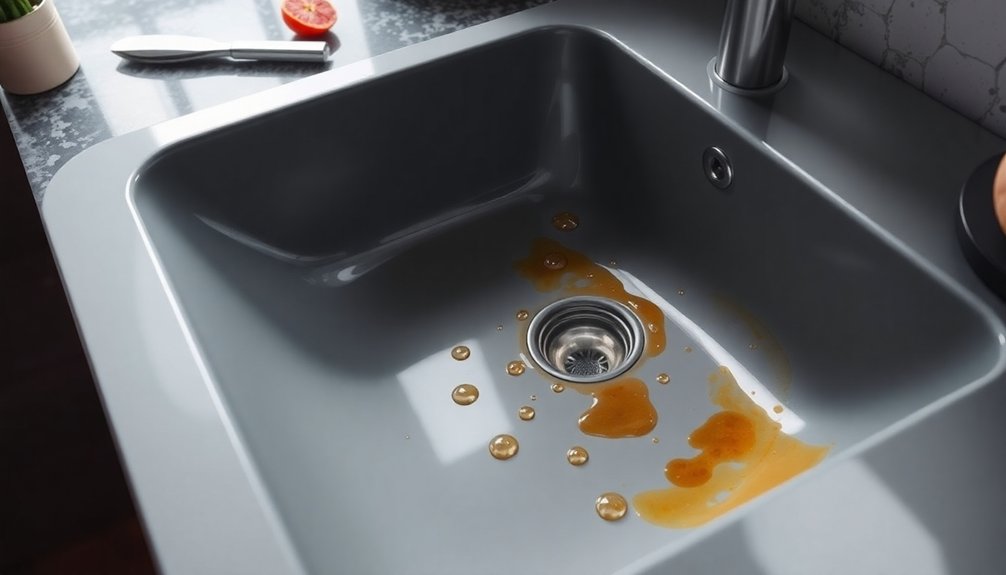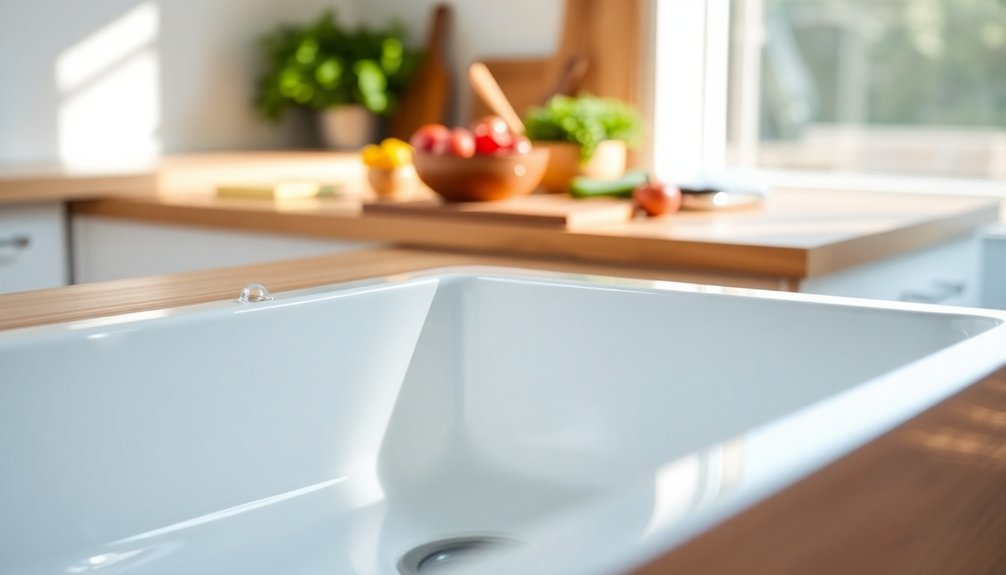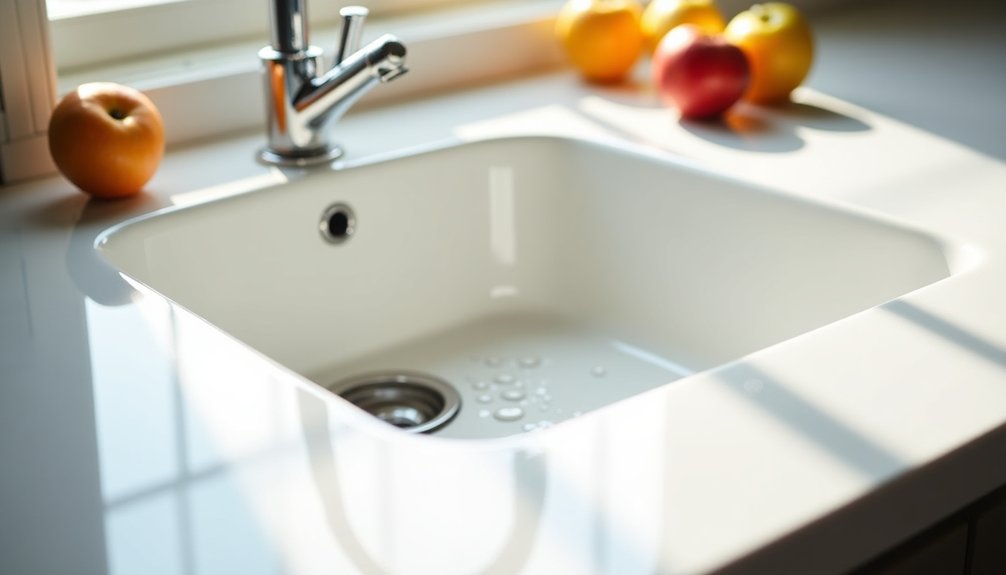Polypropylene sinks can be a solid choice for various uses. They feature a non-porous surface that makes them stain-resistant and easy to clean, even with tougher chemicals. However, while they're lightweight and economical, they may not withstand high heat and can crack under heavy impact. You'll find they're ideal for utility areas or labs, where chemical spills could happen. That said, be aware of potential scratches or fading with extended sun exposure. If you want to explore the pros and cons in more detail, you might find it enlightening to discover what else these sinks can offer.
Key Takeaways
- Polypropylene sinks are highly stain-resistant due to their non-porous surface, preventing penetration from chemicals and dyes.
- They are lightweight and affordable, making them a cost-effective choice for various utility tasks.
- While durable against chemicals, they lack heat resistance and can melt or crack under high temperatures or significant impact.
- Regular use may lead to scratches and fading, particularly with prolonged sun exposure.
- Best suited for laboratories, utility rooms, and craft areas, they excel in environments requiring stain and chemical resistance.
Understanding Polypropylene Sinks
When it comes to choosing a sink, understanding polypropylene sinks can help you make an informed decision. These sinks are crafted from a lightweight thermoplastic material known for its impressive chemical resistance. This characteristic makes them ideal for various cleaning tasks in both residential and commercial settings.
If you're budget-conscious, you'll appreciate that polypropylene sinks are generally more affordable than stainless steel options.
One of the standout features of polypropylene sinks is their wall-mountable design, which allows for versatile installation in tight spaces. This can be particularly beneficial if you're working with limited room in your kitchen or utility area.
Polypropylene sinks also fall under Recycling Code 5, indicating their recyclability, which could be a factor for environmentally aware consumers.
However, it's essential to consider their limitations. While they can handle many chemicals, be cautious with high-temperature tasks, as polypropylene sinks can melt at lower temperatures compared to stainless steel.
Under heavy use, you might notice that these sinks can show signs of wear over time. Prolonged exposure to harsh conditions may lead to fading or discoloration.
Stain Resistance Features
Thanks to their non-porous surface, polypropylene sinks excel in stain resistance, making them a practical choice for busy kitchens and utility areas. This unique feature prevents substances from penetrating the material, ensuring that spills and messes don't lead to unsightly stains.
Unlike some other materials, polypropylene doesn't easily discolor when exposed to common household chemicals or dyes, allowing you to maintain a fresh appearance over time.
The lightweight thermoplastic nature of polypropylene also contributes to its ease of cleaning. With a simple rinse and wipe, you can keep the surface free from grime and potential stains.
Plus, polypropylene's chemical resistance means you can tackle various cleaning tasks without worrying about damaging the sink or leaving stains, even when using harsher cleaning agents.
Polypropylene's heat resistance also means it is safe for hot water and cleaning supplies, as FDA-approved plastics like polypropylene are designed for high-temperature use.
Regular maintenance, like rinsing and wiping down the surface after use, can further enhance the stain resistance of your polypropylene sink. This not only ensures cleanliness but also promotes longevity, making your sink a durable option for everyday tasks.
Durability Comparison

While polypropylene sinks excel in stain resistance, their durability presents a mixed picture. You might appreciate their lightweight and affordable nature, making them an economical choice for utility tasks.
However, when it comes to durability, polypropylene sinks fall short compared to stainless steel sinks. While they resist chemicals well, they lack heat resistance. Exposing them to elevated temperatures can result in melting or deformation, which isn't ideal for heavy-duty use.
Under significant impact, polypropylene sinks can crack, as they aren't as structurally robust as their stainless steel counterparts.
You'll also notice that with regular use, they may show signs of wear and tear, prompting more frequent replacements. If your sink is exposed to prolonged sunlight, fading and discoloration can occur, which may affect its aesthetic appeal over time.
Additionally, polypropylene sinks, like other plastic products, can release microplastics and harmful chemicals into the environment, posing potential health risks over time.
Advantages and Disadvantages
Many homeowners find polypropylene sinks appealing due to their affordability and lightweight design. One of the primary advantages is their cost-effectiveness compared to stainless steel options, making them a great choice for those on a budget. Additionally, their high chemical resistance lets you tackle various cleaning tasks without worrying about degrading the material. The lightweight nature also makes installation and handling easier, a bonus for DIY enthusiasts.
However, it's essential to consider the disadvantages, too. While polypropylene sinks are resistant to stains, they aren't the most durable under heavy use. Over time, you might notice wear, leading to more frequent replacements. They can also be prone to scratches, which may affect their appearance. Furthermore, the use of polypropylene in sinks highlights the importance of BPA-free materials in reducing the risk of chemical leaching and potential health risks.
Another drawback is their susceptibility to melting at lower temperatures, which can be a concern in high-heat environments. Plus, prolonged exposure to sunlight or harsh chemicals can cause fading or discoloration, affecting the sink's aesthetics.
Best Use Cases

If you're considering a polypropylene sink, you'll find it excels in various scenarios. Its stain resistance and durability make it a practical choice for many environments.
Here are some of the best use cases for polypropylene sinks:
- Laboratories: Their non-porous surface resists stains and chemical spills, making them ideal for frequent cleaning.
- Utility Rooms: Lightweight and easy to install, polypropylene sinks fit perfectly in tight spaces, like laundry areas or utility rooms.
- Craft Areas: With decent durability under low to moderate use, they handle messy projects without worry about permanent stains.
- Commercial Cleaning: High chemical resistance allows you to use various cleaning agents without damaging the sink, making it reliable for both commercial and residential settings, which also supports single-use reduction goals by encouraging multi-use alternatives.
Frequently Asked Questions
Are Polypropylene Sinks Any Good?
When considering polypropylene sinks, you'll appreciate their affordability and lightweight design. They're easy to install and resistant to many chemicals, but keep in mind they may not withstand heavy use or prolonged sunlight exposure well.
What Is the Most Durable Material for a Utility Sink?
The most durable material for a utility sink is stainless steel. It withstands heat, impact, and stains, making it perfect for heavy usage. You'll find it lasts longer and requires less maintenance than other materials.
What Sinks Don't Stain or Scratch?
If you're looking for sinks that don't stain or scratch, consider stainless steel, quartz composite, or fireclay. These materials offer excellent resistance, ensuring they maintain their appearance even with regular use and heavy cleaning.
What's the Most Durable Material for Kitchen Sink?
For the most durable kitchen sink material, you can't go wrong with stainless steel. It resists heat, stains, and scratches, making it perfect for heavy-duty use. You'll appreciate its longevity and easy maintenance in your kitchen.

